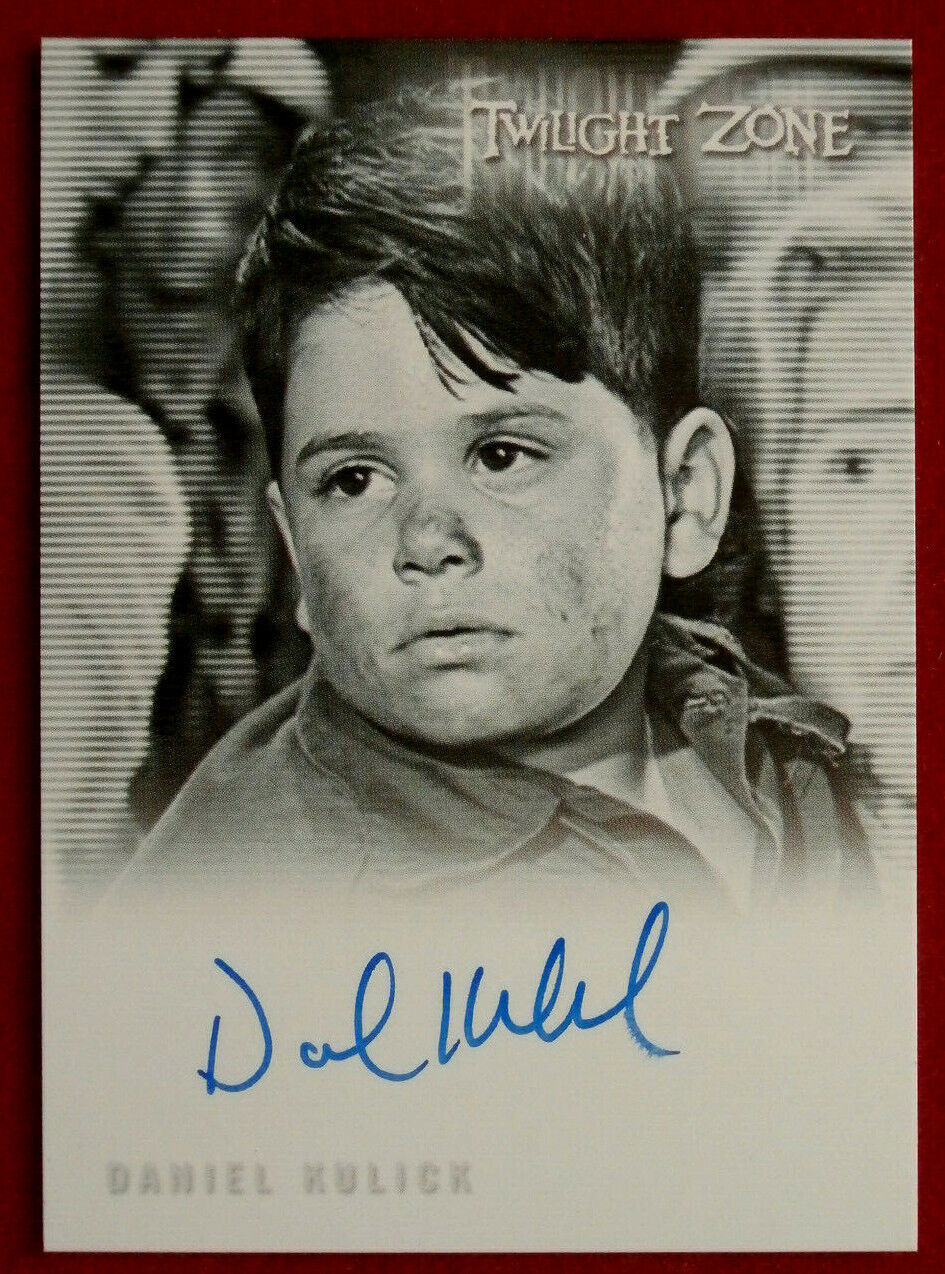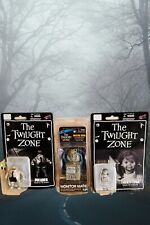TWILIGHT ZONE - DANIEL KULICK - Hand-Signed Autograph Card - LIMITED EDITION For Sale

When you click on links to various merchants on this site and make a purchase, this can result in this site earning a commission. Affiliate programs and affiliations include, but are not limited to, the eBay Partner Network.
TWILIGHT ZONE - DANIEL KULICK - Hand-Signed Autograph Card - LIMITED EDITION:
$55.19
Rod Serling\'s TWILIGHT ZONE - Personally Signed Limited Edition Autograph Card from the series issued by Rittenhouse in 2016.
TheTwilight Zoneis an American media franchise based on the anthologytelevision series created by Rod Serling. The episodes are in variousgenres, including fantasy, science fiction, suspense, horror, andpsychological thriller, often concluding with a macabre or unexpectedtwist, and usually with a moral. A popular and critical success, itintroduced many Americans to common science fiction and fantasytropes. The original series, shot entirely in black and white, ran onCBS for five seasons from 1959 to 1964.
The Twilight Zonefollowed in the tradition of earlier television shows such as Talesof Tomorrow (1951–53) and Science Fiction Theatre(1955–57); radio programs such as The Weird Circle(1943–45), Dimension X (1950–51) and X Minus One(1955–58); and the radio work of one of Serling\'s inspirations,Norman Corwin. The success of the series led to a feature film(1983), a TV film (1994), a radio series (2002–12), literatureincluding a comic book, novels and a magazine and a theme parkattraction and various other spin-offs that spanned five decades,including three revival television series. The first revival(1985–89) ran on CBS and in syndication in the 1980s, while thesecond revival ran on UPN (2002–2003). In December 2017, CBS AllAccess officially ordered the third Twilight Zone revival toseries, helmed by Jordan Peele. The series premiered on April 1,2019.
TVGuide ranked the original TV series #5 in their 2013 list of the60 greatest shows of all time and #4 in their list of the 60 greatestdramas.
As a boy, Rod Serling was afan of pulp fiction stories. As an adult, he sought topics withthemes such as racism, government, war, society, and human nature ingeneral. Serling decided to combine these two interests as a way tobroach these subjects on television at a time when such issues werenot commonly addressed.
Throughout the 1950s,Serling established himself as one of the most popular names intelevision. He was as famous for writing televised drama as he wasfor criticizing the medium\'s limitations. His most vocal complaintsconcerned censorship, which was frequently practiced by sponsors andnetworks. \"I was not permitted to have my senators discuss anycurrent or pressing problem,\" he said of his 1957 Studio Oneproduction \"The Arena\", intended to be an involving lookinto contemporary politics. \"To talk of tariff was to alignoneself with the Republicans; to talk of labor was to suggest controlby the Democrats. To say a single thing germane to the currentpolitical scene was absolutely prohibited.\"
\"The Time Element\"(1958)CBS purchased a teleplay in1958 that writer Rod Serling hoped to produce as the pilot of aweekly anthology series. \"The Time Element\" markedSerling\'s first entry in the field of science fiction.
PlotSeveral years after the endof World War II, a man named Peter Jenson (William Bendix) visits apsychoanalyst, Dr. Gillespie (Martin Balsam). Jenson tells him abouta recurring dream in which he tries to warn people about the \"sneakattack\" on Pearl Harbor before it happens, but the warnings aredisregarded. Jenson believes the events of the dream are real, andeach night he travels back to 1941. Dr. Gillespie insists that timetravel is impossible given the nature of temporal paradoxes. While onthe couch, Jenson falls asleep once again but this time dreams thatthe Japanese planes shoot and kill him. In Dr. Gillespie\'s office,the couch Jenson was lying on is now empty. Dr. Gillespie goes to abar where he finds Jenson\'s picture on the wall. The bartender tellshim that Jenson had tended bar there, but he was killed during thePearl Harbor attack.
ProductionWith the \"TimeElement\" script, Serling drafted the fundamental elements thatdefined the subsequent series: a science-fiction/fantasy theme,opening and closing narration, and an ending with a twist. \"TheTime Element\" was purchased immediately, but shelvedindefinitely.
This is where things stoodwhen Bert Granet, the new producer for Westinghouse DesiluPlayhouse, discovered \"The Time Element\" in CBS\' vaultswhile searching for an original Serling script to add prestige to hisshow. \"The Time Element\" (introduced by Desi Arnaz) debutedon November 24, 1958, to an overwhelmingly delighted audience oftelevision viewers and critics alike. \"The humor and sincerityof Mr. Serling\'s dialogue made \'The Time Element\' consistentlyentertaining,\" offered Jack Gould of The New York Times.Over 6,000 letters of praise flooded Granet\'s offices. Convinced thata series based on such stories could succeed, CBS again began talkswith Serling about the possibilities of producing The TwilightZone. \"Where Is Everybody?\" was accepted as the pilotepisode and the project was officially announced to the public inearly 1959. Other than reruns at the time \"The Time Element\"was not aired on television again until it was shown as part of a1996 all-night sneak preview of the new cable channel TVLand. It isavailable in an Italian DVD boxed set titled Ai confini dellarealtà – I tesori perduti. The Twilight Zone Season 1Blu-ray boxed set released on September 14, 2010, offers a remasteredhigh-definition version of the original Desilu Playhouseproduction as a special feature.
Original series (1959–1964)The series was produced byCayuga Productions, Inc., a production company owned and named bySerling. It reflects his background in Central New York State and isnamed after Cayuga Lake, on which he owned a home, and where CornellUniversity and Ithaca College are located.
Aside from Serling, whowrote or adapted nearly two-thirds of the series\' total episodes,writers for The Twilight Zone included leading authors such asCharles Beaumont, Ray Bradbury, Earl Hamner, Jr., George ClaytonJohnson, Richard Matheson, Reginald Rose, and Jerry Sohl. Manyepisodes also featured new adaptations of classic stories by suchwriters as Ambrose Bierce, Jerome Bixby, Damon Knight, John Collier,and Lewis Padgett.
Twilight Zone\'swriters frequently used science fiction as a vehicle for socialcomment, as networks and sponsors who censored controversial materialfrom live dramas were less concerned with seemingly innocuous fantasyand sci-fi stories. Frequent themes on The Twilight Zoneincluded nuclear war, McCarthyism, and mass hysteria, subjects thatwere avoided on less serious primetime television. Episodes such as\"The Monsters Are Due on Maple Street\" and \"I Am theNight—Color Me Black\" offered specific commentary on currentevents and social issues. Other stories, such as \"The Masks\",\"I Dream of Genie\", or \"Mr. Denton on Doomsday\"were allegories, parables, or fables that reflected the moral andphilosophical choices of the characters.
Despite his esteem in thewriting community, Serling found the series difficult to sell. Fewcritics felt that science fiction could transcend empty escapism andenter the realm of adult drama. In a September 22, 1959, interviewwith Serling, Mike Wallace asked a question illustrative of thetimes: \"...[Y]ou\'re going to be, obviously, working so hard onThe Twilight Zone that, in essence, for the time being and forthe foreseeable future, you\'ve given up on writing anything importantfor television, right?\" While Serling\'s appearances on the showbecame one of its most distinctive features, with his clippeddelivery still widely imitated today, he was reportedly nervous aboutit and had to be persuaded to appear on camera. Serling often stepsinto the middle of the action while the characters remain obliviousto him, but on one notable occasion, they are aware of his presence:In the episode \"A World of His Own\", a writer (Keenan Wynn)with the power to alter his reality objects to Serling\'s narrationand promptly erases Serling from the show.
In season two, due tobudgetary constraints, the network decided – against Serling\'swishes – to cut costs by shooting some episodes on videotape ratherthan film. The requisite multicamera setup of the videotape formatprecluded location shooting, severely limiting the potential scope ofthe storylines, and the experiment was abandoned after just sixepisodes (\"Twenty Two\", \"Static\", \"The WholeTruth\", \"The Lateness of the Hour\", \"The Night ofthe Meek\", and \"Long Distance Call\").
The original seriescontains 156 episodes. The episodes in seasons one through three are30 minutes long with commercials (24 or 25 minutes withoutcommercials). Season four (1962–63) consists of one-hour episodeswith commercials (51 minutes without commercials). Season fivereturned to the half-hour format.
First revival (1985–1989)It was Serling\'s decisionto sell his share of the series back to the network that eventuallyallowed for a Twilight Zone revival. As an in-houseproduction, CBS stood to earn more money producing The TwilightZone than it could by purchasing a new series produced by anoutside company. Even so, the network was slow to consider a revival,turning down offers from the original production team of Rod Serlingand Buck Houghton and later from American filmmaker Francis FordCoppola.
CBS gave the new TwilightZone a greenlight in 1984 under the supervision of Carla Singer,then Vice President of Drama Development. While the show did not comeclose to matching the enduring popularity of the original, someepisodes – particularly Alan Brennert\'s love story \"HerPilgrim Soul\" and J. Neil Schulman\'s \"Profile in Silver\" – were critically acclaimed. In a tribute to the original series,the opening credits include a brief image of Rod Serling. Fourepisodes are remakes of those from the original series: \"Nightof the Meek\", \"Shadow Play\", \"The After Hours\"and \"A Game of Pool\", while \"Dead Woman\'s Shoes\"is an adaptation of \"Dead Man\'s Shoes\". Unlike the originalseries and the second revival, this series does not include theopening monologue during the title sequence. As well, the narrationis all strictly voice-over and the narrator never appears on-screen.
Rod Serling\'s Lost Classics(1994)In the early 1990s, RichardMatheson and Carol Serling produced an outline for a two-hourmade-for-TV movie which would feature Matheson adaptations of threeyet-unfilmed Rod Serling short stories. Outlines for such aproduction were rejected by CBS until early 1994, when Serling\'swidow discovered a complete shooting script (\"Where the DeadAre\") authored by her late husband, while rummaging throughtheir garage. She showed the forgotten script to producers MichaelO\'Hara and Laurence Horowitz, who were significantly impressed by it.\"I had a pile of scripts, which I usually procrastinate aboutreading. But I read this one right away and, after 30 pages, calledmy partner and said, \"I love it,\" recalled O\'Hara. \"Thisis pure imagination, a period piece, literate – some might saywordy. If Rod Serling\'s name weren\'t on it, it wouldn\'t have a chanceat getting made.\"
Eager to capitalize onSerling\'s celebrity status as a writer, CBS packaged \"Where theDead Are\" with Matheson\'s adaptation of \"The Theatre\",debuting as a two-hour feature on the night of May 19, 1994, underthe name Twilight Zone: Rod Serling\'s Lost Classics. The titlerepresents a misnomer, as both stories were conceived long afterTwilight Zone\'s cancellation. Written just months beforeSerling\'s death, \"Where the Dead Are\" starred PatrickBergin as a 19th-century doctor who stumbles upon a mad scientist\'smedical experiments with immortality. \"The Theatre\" starredAmy Irving and Gary Cole as a couple who visits a cineplex where theydiscover the feature presentation depicts their own lives. James EarlJones provided opening and closing narrations.
Critical response wasmixed. Gannett News Service described it as \"taut and stylish, areminder of what can happen when fine actors are given great words.\"USA Today was less impressed, even suggesting that CarolSerling \"should have left these two unproduced mediocrities inthe garage where she found them.\" Ultimately, ratings provedinsufficient to justify a proposed sequel featuring three scriptsadapted by Matheson.
Second revival (2002–2003)A second revival wasdeveloped by UPN in 2002, it was hosted by Forest Whitaker. It wasbroadcast in a one-hour format composed of two half-hour stories, itwas canceled after one season. \"It\'s Still a Good Life\" isa sequel to \"It\'s a Good Life\", \"The Monsters Are onMaple Street\" is an adaptation of \"The Monsters Are Due onMaple Street\" and \"Eye of the Beholder\" is a remake ofan episode from the original series, with Serling still credited aswriter.
Third revival (2019–present)In December 2012, it wasreported that Bryan Singer was developing and executive producing athird revival television series for CBS Television Studios. A writerfor the series was not chosen and the program was not pitched to anynetworks. CBS, which broadcast the original series and first revival,was reportedly interested. In February 2013, Singer told TG Dailythat the project was still in development and that he hoped to directthe pilot and have A-list actors appear on the revival. The followingmonth, he told IGN that a writer with whom he had previouslyworked was in negotiations to join the revival and that he felt\"passionate\" towards the original series and the plannedrevival.
In February 2016, it wasreported that Ken Levine would write and direct the pilot episode ofthe revival series. It was also reported that the series would beinteractive. In November 2017, it was reported that Jordan Peele wasdeveloping a reboot of the series for streaming service CBS AllAccess with Marco Ramirez serving as potential showrunner. InDecember 2017, CBS All Access ordered the third The Twilight Zonerevival to series. It was announced that the series would be producedby CBS Television Studios in association with Monkeypaw Productionsand Genre Films. Jordan Peele, Marco Ramirez, and Simon Kinberg willserve as executive producers for the series and collaborate on thepremiere episode. Win Rosenfeld and Audrey Chon will also serve asexecutive producers. Peele was revealed to be the new host andnarrator in September 2018, and the new opening sequence wasreleased. The series premiered on April 1, 2019.
The second episode of theseries, \"Nightmare at 30,000 Feet\", is based on \"Nightmareat 20,000 Feet\".

Related Items:
$99.99
Bif Bang Pow The Twilight Zone Lot Of 3: Monitor Matt, Talky Tina, Invader NIB
$124.99
The Twilight Zone Talky Tina 18-Inch Prop Replica Doll Limited Edition 520/ 1004
$199.99



